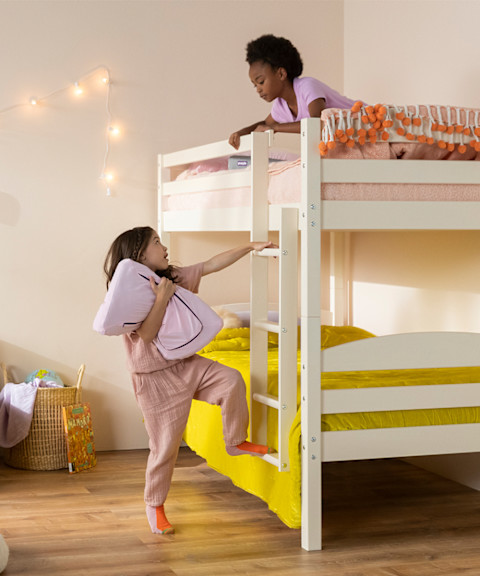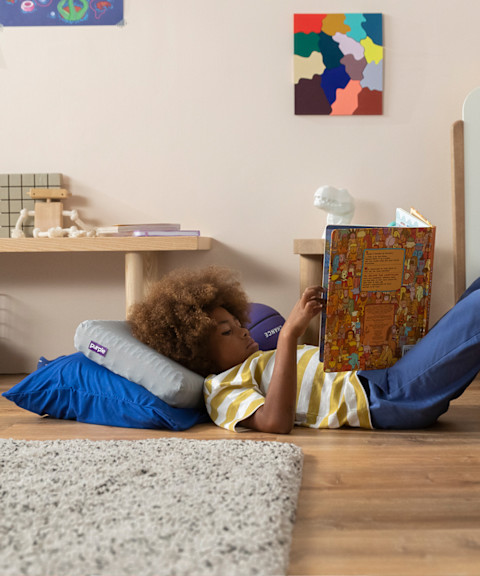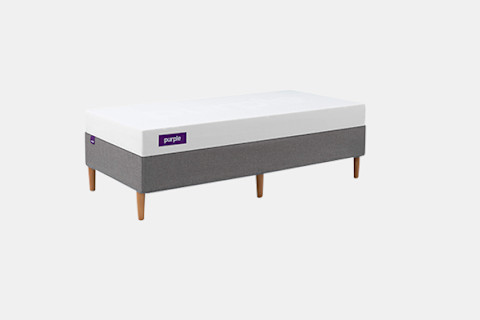How To Put An End To Kids' Restless Nights, From A Certified Pediatric Sleep Expert

As sleep-loving adults, it's hard to get our heads around why in the world kids resist sleep, fight off heavy eyelids, and push bedtime back. After all, a great night's sleep makes us feel great—it's one of the foundations of a healthy, happy, productive life.
To help you and your family get more of those delicious, restorative Zzz's, we spoke to Purple's sleep expert, certified pediatric sleep professional and founder of Tiny Transitions Courtney Zentz, to find out why exactly kids resist sleep and how we can set them up for sleep success.
Why kids resist sleep.
Say it with us now: Sleep begets sleep.
One of the most common reasons younger kids resist sleep is overtiredness. To prevent this, parents need to get a hold on the right awake windows for the baby, infant, or toddler.

"For example," Zentz explains, "a 9-month-old should be awake for about three hours between sleep. A newborn should only be awake about 45 to 60 minutes. And most parents don't know that, so they're asking themselves whether they should be sleeping all day. And the answer is, well, yeah, pretty much!" When kids are not getting enough sleep during the day, that triggers trouble settling at bedtime because they're wired, completely exhausted, and overtired.
If you've got nap times sorted or your kids are growing out of day sleeps and they're still resisting bedtime, turn your focus to habits. Consistently nursing, rocking, bouncing, or driving your child to sleep will teach them to resist sleep until that happens—not very practical on a nightly basis, especially if they're waking up at 2 in the morning!
"Sleep is a skillset fundamentally. If we teach children the skill of sleeping and empower them with the right timing to set themselves up for success, they're going to fall asleep easier. And frankly, it's much easier for them, too. They don't want to rely on the props that they've come to know, but that's how they know to fall asleep."
Here are three simple ways to teach your kids the skill of sleep. You might just find the adults in the family have a thing or two to learn as well!
Set up a sanctuary for sleep success.
Infants need a hard, safe space to sleep above all else. But when kids get a little older and it's time for a mattress, Zentz has noticed in her practice that parents simply aren't cognizant of the need for a child to have a high-quality mattress.
As adults, we research, test drive in-store, study, read reviews, and spend money to get a quality mattress that is comfortable and supportive. Kids, on the other hand, are more likely to get a hand-me-down or the most convenient and cost-effective option available. It's time to think about the importance of support, comfort, and quality for your kids too.
We've done the research, study, and test-drive part for you (we won't lie; testing beds isn't the kind of work we say no to!) and found the perfect option for kids: the new Purple Kid Mattress. This clever mattress offers the same unique Purple Grid™ benefits such as No Pressure Support™, sleeping cool, and instant response, but it's designed specifically for kids under 115 pounds and is optimized to give them the perfect amount of comfort and support. Plus, it has a kid-friendly, machine-washable cover! It's supremely comfortable and, when paired with the Kid Purple Pillow, Kid Sheets, and Purple Foundation, creates the perfect space for kids to rest.
Zentz shares, "I spend money on pillows for my kids, their comforters, their mattress because I want them to be in a place of rest. You sleep where you're comfortable, so I think it's important to treat the bedroom for your children like a sleep sanctuary."
Blackout blinds are another one of Zentz's secret weapons for sleep success. "Most kids (and adults) sleep well in darkness. That's how the body clock works—our circadian rhythm is based on light and dark. The lightest stage of sleep is between four and six in the morning, so you've got to make sure the environment is conducive to a kid not wanting to get up at 5 a.m. because they can see the sun coming up or hear the birds chirping."
Depending on the individual, add-ons like a lavender diffuser, white noise machine, or a night light (Expert tip: Zentz uses a Himalayan salt lamp that can be dimmed as a nightlight for her daughter to avoid blue-light exposure) may also help create that safe, comfortable environment for a deeper sleep.
Create a mental sanctuary.
Creating a mental sanctuary is just as important as setting up that physical sanctuary. It's all about sending the whole family off to bed in a positive, calm, and imaginative state of mind.

The first step is to put down the phones. We get it; that's easier said than done. But, as Zentz shares, "Blue light stimulates the brain; that's just what it does. It specifically triggers certain parts of the brain that tell it to keep going, which is why even adults look at their phone in the middle of the night, and then they can't fall back to sleep because their brain thinks it's ready to get up." To combat this, Zentz recommends instituting a docking station for phones and having all family members (parents included) put the devices down and decompress about an hour before bedtime.
Creating a little ritual that helps the whole family wind down before bed is another great way to set up that mental space. Meditation helps quiet the mind and body, helping to send kids (and adults!) off to bed free from the racing thoughts of the day. If you choose to use an app to guide your meditation, try to minimize your exposure to blue light while you settle in and turn off your notifications so you're not tempted to check emails or messages when you finish. If meditation's not your thing, try journaling, or reading (books, not devices!) together as a family.
Teach kids the value of sleep.
Part of the reason we grown-ups cherish sleep is that we just feel better when we've had a good night's rest. If we can teach kids that sleep helps them do the things they love, they'll grow up understanding the importance of sleep hygiene and good bedtime habits.
"A huge trigger for a lot of school-age kids is after-school activities." Zentz shares, continuing, "If they really want to be good at soccer, be the best athlete, be good at karate or gymnastics or music, sleep is going to help them perform at their best." Teach your kids that their heroes sleep and eat well, and that's how they find the energy to do the things they love and reach peak performance.
Alternatively, it could be one-on-one time that motivates them to get to bed. Children crave attention, and they'll get it whenever they can, even if it's in the middle of the night! Setting up a bedtime routine that includes quality-time storytelling, drawing, or journaling together will help them look forward to bedtime and will fill their cup to ensure they're not looking for that attention in the middle of the night or early in the morning.
The final word.
Sleep is all about consistency—and that doesn't stop when you reach adulthood. Having a consistent bedtime, setting up a routine that helps you wind down, creating a sanctuary for sleep, and investing in a high-quality, comfortable mattress from Purple will help the whole family rediscover the joy of a good night's rest. Make sleep a priority, and all your other priorities, like exercise, work, and quality time with the family, will come a little easier.



